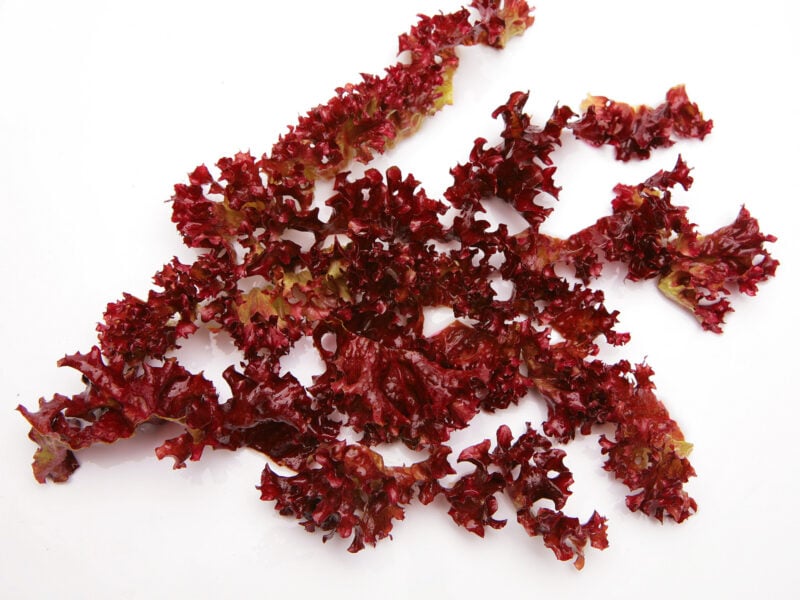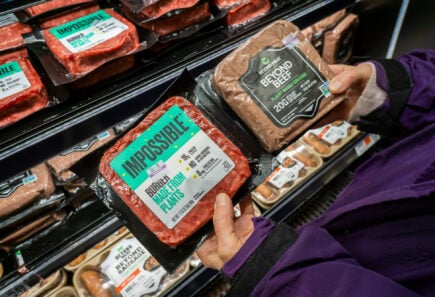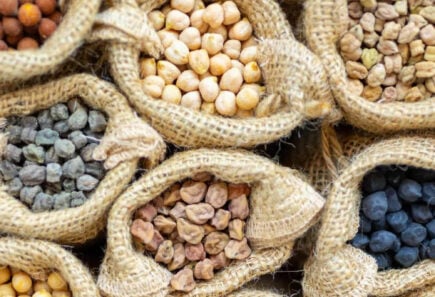
Plant-based meat
This is your guide to plant-based meat. Explore GFI’s tools, resources, events, and expert analysis of the plant-based meat field, from science and technology to policy and markets.
What is plant-based meat?
Plant-based meat is produced directly from plants. Instead of relying on an animal to convert plants into meat, we can make meat more efficiently by skipping the animal and turning plant ingredients directly into meat.
Like animal-based meat, plant-based meat is composed of protein, fat, vitamins, minerals, and water. Next-generation plant-based meat looks, cooks, and tastes like conventional meat.
Where does plant-based meat fit in the alt protein landscape?
Plant-based meat is the cornerstone of alternative proteins in the United States and around the world.
Alternatives to meat like tofu and tempeh have been around for thousands of years. The plant-based meat industry in the United States dates back to the 19th century, and several of today’s leading plant-based meat companies were established in the 1970s–90s.
However, the plant-based meat category remained small and relatively stagnant until recently, with the market largely limited to vegans and vegetarians.
The plant-based meat market has expanded significantly in the past several years, as companies produce plant-based burgers and other products that are virtually indistinguishable from conventional meat.
This “biomimicry” approach began in 2012 with the launch of Beyond Meat’s chicken strips, and it really took off with the 2016 launch of the Impossible Burger and the Beyond Burger, both of which have succeeded in mainstream fast-food outlets.
Why is plant-based meat important?
Like cultivated meat and fermentation-derived products, plant-based meat is better for the planet, people, and animals.
Analyses of the environmental impact of plant-based meat show that plant-based meat production uses 72-99 percent less water and 47-99 percent less land. Further, it causes 51-91 percent less water pollution and emits 30-90 percent less greenhouse gas emissions. By transitioning to plant-based meat and other alternative proteins, we can use far fewer natural resources and enable entire ecosystems — and the biodiversity those systems support — to recover, function, and thrive.
Plant-based meat production does not require any antibiotics. This helps address the broad overuse of antibiotics in meat production. According to the New York Times, in the United States, between 70 and 80 percent of antibiotics sold are consumed by farm animals. On our current trajectory, we are rapidly creating antibiotic-resistant superbugs and risk causing the end of working antibiotics. By shifting to alternative proteins like plant-based meat, we can significantly decrease antibiotic use in our food production and keep antibiotics working for human health and wellbeing.
By taking animals out of the equation, plant-based meat also significantly lowers the risk of future pandemics.
What needs to be done to advance plant-based meat?
The research landscape for plant-based meat offers tremendous scientific opportunity.
High-fidelity plant-based meat that appeals to meat-eaters is a relatively recent innovation. Although tofu, tempeh, and seitan have existed for centuries, we’ve only recently discovered how to produce plant-based meat that offers a nearly indistinguishable sensory experience as a conventional burger or chicken nugget.
Relative to other scientific disciplines like clean energy, very little R&D has been conducted in the plant-based meat field. This field offers great opportunities for scientists seeking novel research topics that can make a significant positive impact on the future of food.

Page
The science of plant-based meat
Learn about the science of plant-based meat. Discover resources and research on the latest technological developments and key scientific questions.
Discover plant-based meat research projects
To fill gaps in foundational alternative protein science, we operate a Competitive Research Grant Program. This program is made possible by funding support from a group of generous donors. Explore some of our plant-based research grants.

Valorizing agricultural side streams
GFI grantee Dr. Marieke Bruins at Wageningen University in the Netherlands is valorizing agricultural side streams for alternative proteins.

Scaling cashew apple supply
GFI grantee Dr. Dionisio is researching cashew apples as a raw material for plant-based meat and solving scale-up challenges in the supply chain.

Creating fiber-like structures
Learn how GFI grantee Dr. David Julian McClements is developing an alternative to extrusion for producing plant-based meat at the University of Massachusetts.

Texturizing proteins and fiber
GFI grantee Dr. Girish Ganjyal at Washington State University is texturizing proteins and fiber to make better plant-based meat.

Texturizing seaweed proteins
Learn about Dr. Yoav Livney’s work at The Technion – Israel Institute of Technology texturizing seaweed proteins for plant-based seafood.
Plant-based meat is a rapidly growing market sector
The market for plant-based meat has grown dramatically in recent years. Since GFI began publishing market data in 2017, retail growth has increased by double-digits every year, far outpacing conventional meat sales. Restaurant chains from Carl’s Jr. to Burger King have had great success adding plant-based meat options to their menus. The world’s biggest food and meat companies — from Tyson to Nestle — have also successfully introduced and marketed new plant-based meat products. Consumer demand is growing.

Resource
State of the Industry Report: Plant-based meat, seafood, eggs, and dairy
This report details the commercial landscape, sales, investments, public funding, and innovation trends in the plant-based meat, seafood, egg, and dairy industry.
Featured resources

Alternative protein company database
Explore the landscape of plant-based, cultivated, and fermentation companies including consumer brands, manufacturers, and ingredients companies.
Plant-based retail market overview
Explore sales data for plant-based meat, egg, and dairy products in the U.S. retail market. Find key category insights, size, sales growth, and purchase dynamics for the plant-based industry.

Startup manual
This guide lays out the steps involved in starting an alternative protein company, from securing funding and developing your product to scaling up and expanding distribution.

GFIdeas Community
Learn from and network with experts in alternative protein. GFIdeas is a community for entrepreneurs, scientists, students, and subject matter experts.
Plant-based meat needs a level playing field & public funding
While many of the world’s biggest companies are selling plant-based meat, some special interests want to stifle better, more efficient meat production and consumption. GFI works to ensure that plant-based meat and other alternative proteins can compete fairly in the market and that governments invest in public research for these groundbreaking fields.

Page
Advocating for fair labeling
Alternative proteins need a fair competitive landscape. Learn how GFI advocates fair public policy that places all proteins on a level playing field.

Page
Securing government funding
Government support will accelerate the growth of alternative proteins. Learn how GFI works to secure public funds for alternative protein research.
Making the case
The Good Food Institute regularly submits expert comments to state and federal agencies, making the case for plant-based meat and other alternative proteins.

Page
Environmental benefits of alt proteins
How eco-friendly are plant-based and cultivated meats? Explore their climate impacts and resource requirements relative to conventional meat.
Expert perspectives
The plant-based meat field moves fast. GFI keeps readers up-to-date through regular posts from our experts around the world.

Our top 23 of 2023
Our global community grew alternative protein progress from the ground up this year. Check out the top highlights.

The top climate moments of this year and what they mean for alternative proteins
Our food system and climate are inextricably linked. The climate community is starting to take notice, zeroing in on protein.

Inviting everyone to the table
Giving Green, Charity Navigator, ACE, and Founders Pledge recognize GFI’s impact as a field catalyst and convener

Plant protein for a regenerative food system
The vital connection between legumes and soil health in our food system.

Support our work
Our work to advance and accelerate the plant-based protein field is made possible by our generous, global family of donors. Philanthropic support is vital to our mission. Connect with us today to discuss how you can help fuel this transformative work.

To the Biden transition team on investing in alternative proteins
To OMB on research funding in Fiscal Year 2022
Re: food standards; general principles and food standards modernization